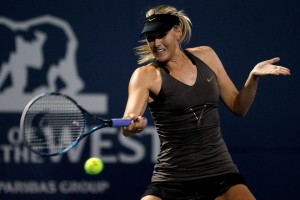Double fault, long, and on break point. Double fault again, long — again on break point. And there would be five more doubles for Maria Sharapova in this extremely disappointing performance against Serena Williams in the Stanford quarterfinals late Friday night.

I haven’t watched much women’s tennis since Wimbledon because the spirit hasn’t moved me to tune into a herd of players who are, yes, pretty good but who don’t have the qualities necessary to be great.
But now, at last, here was Williams vs. Sharapova with more than a dozen Grand Slam singles titles between them and, more importantly, two players equipped to finally get women’s tennis moving again. They are the two biggest personalities on the WTA Tour and they were playing each other for the first time since the fourth round at the 2010 Wimbledon, which Williams also won, by 7-6 (9), 6-4.
This latest match, played under the lights at Stanford University, wasn’t nearly as close at 6-1, 6-3, and it was a letdown for just about everyone except the Williams camp.
Yes, the WTA seriously needs more Williams vs. Sharapova matches to re-pique interest in its product, but the women’s tour would get a lot more bounce out of this coupling if these two major personalities could play them a lot closer.
Williams was close to perfect in the opening set, aggressively hitting both corners with ground strokes off both sides to tear off to a 5-0 lead while Maria could put only 50 percent of her first serves into play.
“It’s sport. You win some, you lose some. You move on,” Sharapova said in her post-match press conference, trying to minimize the devastation of this loss.
More was expected in this first tournament for her since she reached the Wimbledon final, losing to surprise champion Petra Kvitova. She had serving problems right through Wimbledon and she had serving problems at Stanford, and it leaves me and, I’m sure, her coach, Thomas Hogstedt, perplexed.
This isn’t Justine Henin at 5-foot-5 trying to reach up as high as possible to torque the ball into play. Maria is 6-foot-1 and that should make serving easier. She’s changed her delivery since the shoulder surgery to make the service motion a little smoother, and, with her power, there’s no excuse for all the double faults.
The toss is high enough, though she could be more consistent in her toss placement, and she’s catching the ball at the apex. All that seems like the right stuff. But when she faults, it’s usually long or wide — seldom into the net — and that’s often an indication that she’s not snapping her wrist over the ball, giving it the downward spin it needs to get into the box.
But, who knows? It could be a rhythm problem. It could be a fear problem — fear that opponents like Serena Williams and Sabine Lisicki are going to rough up her second, making her think she has to take more risks with her seconds.
Whatever the reason, it’s astonishing that she never called for Hogstedt to come to her changeover chair, exercising her right to have one coaching conference per set.
She did make one adjustment into the second set. She reduced her first-serve speed in order to get a higher percentage in and not leave herself feeling vulnerable on the seconds. But that doesn’t really work against power players like Williams, who started treating Maria’s first serve as if it was a second.
“I felt extremely late. I didn’t have my timing today at all,” she said. No one who follows women’s tennis will forget the second time these two played, with Sharapova winning in the 2004 Wimbledon final. But Williams now leads 7-2 overall and has won the last six.
With Henin re-retired, Kim Clijsters leaving possibly before the end of the year, Venus Williams no longer good enough to be favored to win any Slam and Caroline Wozniacki continuing as a suspect No. 1, tennis needs Sharapova vs. Williams.
But the next time they face off, hopefully on the road to the U.S. Open, we need some drama, not a tail-kicking.
